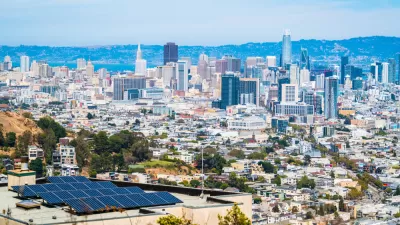While it's fun to tease about the architectural shortcomings of most newly constructed urban residential buildings in the United States, the causes of its ubiquitous sameness reveals the depths of the country's housing crisis.

Patrick Sisson writes:
A wave of sameness has washed over new residential architecture. U.S. cities are filled with apartment buildings sporting boxy designs and somewhat bland facades, often made with colored panels and flat windows.
After posing the question to Twitter of what to call this new ubiquitous style of residential architecture, Sisson was met with a "goldmine."
Some suggestions seemed inspired by the uniformity of design in computer programs and games: Simcityism, SketchUp contemporary, Minecraftsman, or Revittecture. Some took potshots at the way these buildings looked value-engineered to maximize profit: Developer modern, McUrbanism, or fast-casual architecture. Then there are the aesthetic judgement calls: contemporary contempt, blandmarks, LoMo (low modern), and Spongebuild Squareparts.
But what to call contemporary residential architecture is less important than how it got to look so similar. According to Sisson, these buildings are a symbol of the contemporary housing crisis: a lack of developable land, rising costs (land, materials, labor), and an "acute" lack of affordable housing. The similar look of new residential construction in geographically disparate and cultural unique cities all over the country comes down to code, costs, and craft, according to Sisson.
FULL STORY: Why do all new apartment buildings look the same?

Alabama: Trump Terminates Settlements for Black Communities Harmed By Raw Sewage
Trump deemed the landmark civil rights agreement “illegal DEI and environmental justice policy.”

Study: Maui’s Plan to Convert Vacation Rentals to Long-Term Housing Could Cause Nearly $1 Billion Economic Loss
The plan would reduce visitor accommodation by 25% resulting in 1,900 jobs lost.

Why Should We Subsidize Public Transportation?
Many public transit agencies face financial stress due to rising costs, declining fare revenue, and declining subsidies. Transit advocates must provide a strong business case for increasing public transit funding.

Paris Bike Boom Leads to Steep Drop in Air Pollution
The French city’s air quality has improved dramatically in the past 20 years, coinciding with a growth in cycling.

Why Housing Costs More to Build in California Than in Texas
Hard costs like labor and materials combined with ‘soft’ costs such as permitting make building in the San Francisco Bay Area almost three times as costly as in Texas cities.

San Diego County Sees a Rise in Urban Coyotes
San Diego County experiences a rise in urban coyotes, as sightings become prevalent throughout its urban neighbourhoods and surrounding areas.
Urban Design for Planners 1: Software Tools
This six-course series explores essential urban design concepts using open source software and equips planners with the tools they need to participate fully in the urban design process.
Planning for Universal Design
Learn the tools for implementing Universal Design in planning regulations.
Smith Gee Studio
Alamo Area Metropolitan Planning Organization
City of Santa Clarita
Institute for Housing and Urban Development Studies (IHS)
City of Grandview
Harvard GSD Executive Education
Toledo-Lucas County Plan Commissions
Salt Lake City
NYU Wagner Graduate School of Public Service





























